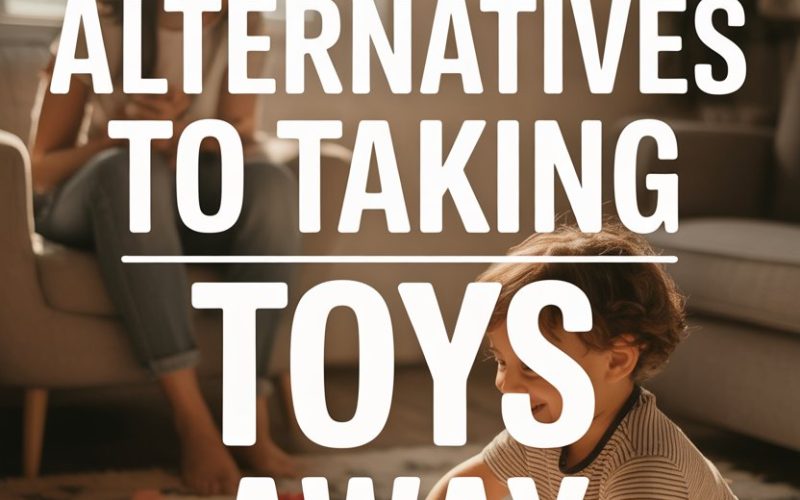Everyone has had that moment: your child is on a roll (and not the good kind), and you reach for the old faithful—taking the toy away.
Maybe it’s LEGO bricks mid-construction, or a princess in peril, but the result is always the same—cries, drama, and a gnawing guilt that you’ve just crushed a creative spirit, all before teatime.
If you’re reading this, perhaps you’re ready for a few new tricks in your parental toolbox.
Good news: there’s more than one way to teach a lesson (and keep your eardrums intact).
Here’s five science-backed, sanity-saving alternatives for the next time you’re tempted to channel your inner toy-thief.
1. Offer Choices Within Limits
When tempers flare and the toy is about to become collateral damage in a sibling standoff, offering choices can redirect the situation faster than you can say “who wants a snack?”
Instead of snatching the toy or launching into a monologue about sharing (which, let’s be honest, sounds suspiciously like nagging), try this: “You can keep playing with the blocks with your brother, or you can save them for later and draw together now. What do you pick?”
Kids are hardwired to resist being bossed about, but thrive when given some control (expert child psychologist Dr. Laura Markham) says it helps them feel respected and more likely to cooperate.
The key here? Both choices are options you’re happy with. No need to offer ‘Cake for breakfast’ as an out, tempting as it is.
It’s a great way to avoid the power struggle entirely and teach decision-making in the process. Side benefit: you’ll sound like the world’s most reasonable grown-up.
2. Use Natural Consequences
Picture the scene: your child throws a puzzle piece across the room in a fit of frustration.
Instead of swooping in for a dramatic rescue (or confiscation), let the consequence play out—no puzzle to finish until all the pieces are retrieved.
Natural consequences aren’t about being punitive—they’re about letting the outcome teach the lesson.
If a child refuses to wear a coat, let them feel a minute or two of cold before you come to the rescue with a warm hug and the offer of their jacket.
Of course, this doesn’t mean letting them play with matches or use the iPad as a frisbee. Safety first, always.
But letting small, safe mishaps happen teaches cause and effect far better than the threat of toy exile ever could. (Harvard’s Center on the Developing Child) confirms that experiencing real-life results helps build crucial life skills like self-control and problem-solving.
3. Model and Teach Emotional Skills
Toys are often unwitting accomplices in childhood drama. That cherished train set isn’t really the problem—it’s the tidal wave of feelings beneath the surface.
The trick? Teach emotional skills, not just rules.
When your child’s frustration hits DEFCON 1, kneel beside them and name the feeling: “You’re angry because you wanted to be the train driver first. That’s tough.”
This simple act of labeling emotions helps kids make sense of their big feelings (Psychology of Learning and Motivation).
From there, walk them through a quick calming strategy—deep breaths, squeezing a soft toy, even a silly ‘angry dance’ to shake it off.
Once calm, chat about better ways to handle it next time. “Next time you’re angry, what could you do?” This turns an explosive moment into a teaching opportunity, and everyone keeps their toys (and dignity) intact.
4. Connect Before You Correct
Ever notice how discipline works better when your child actually likes you?
Before laying down the law, spend a minute connecting—eye contact, a gentle touch, or even a quick cuddle (assuming you haven’t just been brained with a Hot Wheels car).
Connection is magic. It tells your child: “I’m on your side, even when you’ve made a mess of things.”
According to Dr. Daniel Siegel, child psychiatrist and co-author of The Whole-Brain Child, emotional connection primes the brain for learning, making kids more receptive to correction.
You might say, “I see you’re upset. Can we talk about what happened?” or “I want to help you work this out. How do you think we can fix it together?”
Correcting from a place of warmth and understanding means fewer tears, less drama, and—miracle of miracles—sometimes an actual apology. It sounds soft, but it works hard.
5. Use Positive Reinforcement and Praise
If you’ve ever trained a puppy (or a partner), you know that catching someone doing the right thing works wonders. Kids are no different.
Instead of pouncing when they’re caught mid-tantrum, try spotlighting the good stuff.
When your child shares that toy train without prompting, make a big fuss: “Wow, I noticed you let your sister have a turn! That was really kind!” Or even a simple high-five can work wonders.
The science behind this is solid—the American Academy of Pediatrics highlights that positive reinforcement builds self-esteem and encourages repeat performances.
Get specific with your praise, and keep it authentic.
Kids can spot sugar-coating a mile away. “You put your blocks away so carefully,” trumps a generic “Good job!” any day.
And the best part? Positive reinforcement is a lot more fun for everyone than the role of Reluctant Toy Snatcher.
When You’re Tempted to Hide Every Toy in the Cupboard
Even the most creative parenting hacks can fall flat on a day when nothing seems to work.
Your youngest just painted the cat with yogurt, your eldest is lobbying for more screen time, and you’re pretty sure you’ve lost your coffee somewhere under a pile of Happy Meal toys.
On those days, remember: you’re not raising a robot, you’re raising a real, gloriously messy human being. Kids learn best from patience, connection, and a smidge of humour.
And every time you resist the urge to take a toy away, you’re helping your child build skills for life—not just for living room diplomacy.
If all else fails? Hide in the bathroom for five minutes.
Just don’t take your phone. Or any toys.





